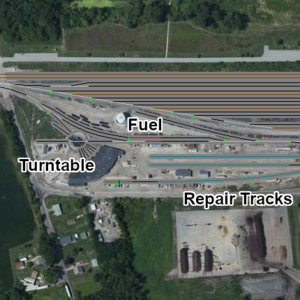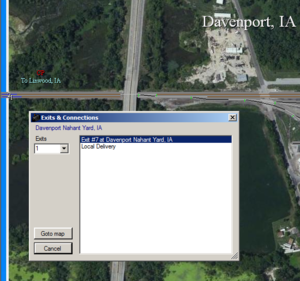Tutorial X - Yard Work at Davenport IA
Please note that this tutorial is under development, and the tutorial trains are not yet available.
Contents
Setup
For this tutorial, it is assumed that you have completed Tutorial 1 - Switching at Rolla CO. Following that tutorial, you know how to drive trains and change switches, couple and uncouple cars, how the delivery of cars to industries works, and how to assign a new Train Symbol and Route (TSAR) to a train so you can send it onwards.
Introduction
This tutorial takes place at Davenport Nahant Yard, IA. Nahant Yard is owned by the Canadian Pacific (CP) railroad, and is located on the western bank of the Mississippi River. To the north, the CP mainline continues on towards St. Paul, MN, in which a major sorting yard is located; additionally, one of CP's main routes to the major railroad hub of Chicago branches off 50 miles north of Davenport, crossing the Mississippi River at Savannah, IL. South of Davenport, the CP line heads to its terminus at Kansas City, MO. CP interchanges cars with numerous other railroads at Kansas City, including BNSF, KCS, and UP.
Nahant Yard is CP's main sorting yard for the region around Davenport. In addition to serving industries in Davenport itself, CP also serves a cement plant, a quarry, and several barge terminals at Linwood, IA, six miles south of Davenport - both of these are represented on the FYM Davenport map. CP also interchanges cars with two other railroads on the other side of the Mississippi River at Rock Island, IL: the Iowa Interstate (IAIS) railroad, which is a regional railroad serving Iowa and Illinois, and the Burlington Northern Santa Fe (BNSF) railroad, one of the seven major Class 1 railroads in the US.
Interchanging cars
If a shipment is carried from one location served by CP to another location also served by CP, CP will take charge of the freight car throughout its journey. However, if freight is being delivered to a location on a different railroad company, the car must be routed to a location where it can be interchanged to the other railroad, at which point the other railroad takes charge of the car and delivers it to its final destination. In some situations, it may even be the case that the origin and destination railroads do not interchange at all - in such a case, a third railroad will need to be involved to move the car between them.
As railroads are only paid for moving a freight car on their own track, they will generally attempt to move it as far as possible before interchanging it. However, in order to expedite the movement of traffic (and reduce costs), major railroads regularly agree to route traffic in a more neutral manner through major interchange hubs, rather than taking it to an inconvenient branchline interchange location simply to gain a few extra miles.
Unit trains
In Tutorial 1, we only encountered manifest traffic. Manifest trains are made up of many single freight cars, or small groups of freight cars, moving from a variety of origins to a variety of destinations. This is in contrast to unit trains, which carry a single commodity from one location to another - common types of unit train include coal, grain, and crude oil. While manifest traffic is usually interchanged between railroads by taking it to a sorting yard, delivering it to the other railroad's yard using a local, and then sorting it again, unit trains are interchanged by simply delivering the entire train to the other railroad. It may even be that the originating railroad's locomotives will simply carry on with the train, returning to their home railroad once the train has been loaded or unloaded.
Downloading the Map and Trains
As in Tutorial 1, you will need to download the map and trains. The map to download is IA: Davenport Nahant Yard, 2128.
Note: if you have already been registered as a player, you will not see the tutorial trains listed in the Maps and Trains window. The trains can still be accessed by selecting "Download Tutorial Trains" in the "Tutorial" menu on the toolbar.
There are several trains to download, which can be found in the top right panel of the Maps and Trains panel, all of which have names of the form Y2128-xxExxFxxxCx-xxxxx-Tutorial2.zrn.
A look around Davenport
Open the Davenport, IA map and have a look around. Nahant Yard is located at the far left of the map, and contains a large number of long tracks for sorting trains. In addition, at the left hand end of the yard are a number of facilities, labelled in the image on the right. Sidings 1 and 2 unload various materials for railroad maintenance. The two red tracks are fueling facilities - locomotives require regular refueling in FYM, as in real life. The three turquoise tracks are repair tracks, used to repair either cars or locomotives that have become damaged - either through coupling trains at excessive speed, or simple through random wear and tear. The short light blue track is a turntable, which can be used to rotate locomotives, and provide access to the various tracks in the roundhouse.
Following the mainline to the right, we pass a number of industries - some located down long spur tracks - and West Davenport Yard, which provides additional sorting and car storage space. Just beyond West Davenport Yard the mainline splits twice, and leaves the map in three different directions. The middle of the routes via Exit 4 is the CP mainline to St Paul and Chicago, continuing north on the west side of the Mississippi.
The other two lines through Exits 3 and 5 both cross the Mississippi River to reach Rock Island, IL. The bottom line through Exit 5 leads to a number of CP-served industries and the interchange with the BNSF. The topmost line through Exit 3 connects to the IAIS line just outside of the map, and then proceeds to their yards in Rock Island and Silvis, IL. More information on where exits lead can be found by clicking on the exit - doing so on Exit 5 shows that it leads to Rock Island CP, while Exit 3 leads to Rock Island IAIS.
The Linwood Panel
Returning to the left side of the map, clicking on Exits 1 and 2 will show that, somewhat surprisingly, they connect to Davenport Nahant Yard - the map they appear to be leaving! This is because this map covers multiple, separate parts of the railroad as separate panels - if you move the map down beyond the bottom of Nahant Yard, you will find a separate piece of the map covering the industries at Linwood, IA. The exit information window helpfully has a "Goto map" button, which will center the view on the exit at the other end of the connection (and, if the exit is on another map that is downloaded, will open that map).
The Linwood panel is relatively simple operationally - the mainline proceeds past from right (Davenport) to left (Kansas City). The various industries are all located below the mainline, and while there are a few areas for sorting or storing cars, the available space is actually quite limited. Additionally, these industries can only be accessed from the bottom mainline - there is no crossover between the two main tracks, and so any train serving these must leave Nahant Yard via Exit 1.
Panels are used in FYM to make maps more interesting, by effectively combining multiple maps under one Yard Master. The panels generally behave as if they were entirely separate maps, and may even be assigned separate map identities for the purposes of routing cars. The adjacent Rock Island map is an example of this. That map contains three map identities for Rock Island itself - one each for the BNSF, CP, and IAIS railroads, with some industries associated with multiple identities - and a further two map identities for another panel containing Silvis (IAIS) and Moline (BNSF).
The Trains
Unlike Tutorial 1, this time you are provided with multiple trains to handle. These trains illustrate some of the variety seen within FYM.
CP B73
Rock Island Local
This train is a local, returning to Nahant after servicing industries at Rock Island. It is carrying a number of outbound cars that we will need to route onwards towards their destinations. The train is pulled by a single GP38-2, a small switching locomotive, commonly used for delivering cars to industries and sorting cars within yards. We will use this locomotive to arrange cars for outbound trains, sort those arriving on inbound trains, and deliver cars to some of our industries.
IAIS RISW
IAIS-CP Transfer
Although Nahant Yard is operated by CP, this train is an inbound transfer of cars from the IAIS, originating at their Silvis yard. As with the CP local, we will bring the train into our yard for classification into outbound trains. In addition, we will collect any cars bound for the IAIS, and transfer them back using the locomotives on this local - make sure not to send the IAIS locos away on a CP train, as the owners will be quite upset about losing them!
CP 574
Unit Oil Train
This is a through unit train, carrying crude oil from oilfields in Alberta, Canada to refineries in Baton Rouge, LA. Note that this train has locomotives at both the front and the rear - this arrangement is known as distributed power, with the rear locomotive being remotely controlled by radio signals, and makes the train both easier and safer to handle. However, note that not all locomotives are capable of working as distributed power units (DPU) - only more modern locomotives can do so, typically those with 4000HP or more of power. The train also contains some empty buffer cars at either end; these are a requirement of trains carrying hazardous materials, to protect the locomotives and crew in case of an accident. As this is a unit train, it is not planned to pick up or set out cars at Nahant. However, the locomotives are low on fuel, and we will refuel them.
CP 474
St Paul-Kansas City Manifest
Train 474 is a through manifest freight from St Paul to Kansas City. Manifest trains do not call at all yards and industries en route; if they did so, it would take weeks for them to reach their final destination. Instead, they deliver cars from one large sorting yard (their origin) to another (their destination), sometimes calling at intermediate locations to pick up (add) and set out (remove) cars. Nahant Yard is indeed a major yard on this route, and both CP 474 (St Paul-Kansas City) and CP 475 (Kansas City-St Paul) stop here.
CP 475
Kansas City-St Paul Manifest
Travelling in the opposite direction to 474, this train carries manifest traffic interchanged from the BNSF, KCS, and UP at Kansas City for various CP destinations.
CP 473
Chicago-Davenport Manifest
This train is a Chicago-Nahant manifest, carrying freight for the Nahant area, interchange to the IAIS, and for onward movement to Kansas City via CP 474. We will terminate this train here, and build a return CP 472 service carrying traffic for Chicago.

